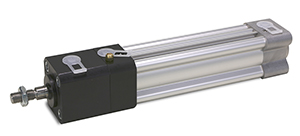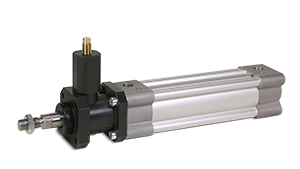From Parker Hannifin & MCE Pneumatics Teams
In today's modern, fully automated manufacturing applications, assessing the potential risks to personnel is an essential part of overall system design. It’s vital to take appropriate measures to reduce the risk of injury to machinery operators or those in the vicinity and prevent damage to the products being assembled or manufactured. During any kind of stop in operation, the equipment must be rendered safe; this is an installation prerequisite.
One of the most common causes of a stop in a process is an interruption to the power driving the system. Usually in industrial automation systems the method of power is electrical, hydraulic fluid or compressed air.
In pneumatic systems, power removal is typically associated with a break or significant drop in the air supply pressure. Typically, this can be caused by either the failure of a compressed air pump or other equipment, or by a major breach or leakage in the supply line.
Where the need for safety is deemed critical and "safe" failure is a necessity, one solution is the utilization of rod locking cylinders.
How Do Rod Locking Cylinders Deliver Safety?

Rod locking pneumatic cylinders,
such as Parker's P1F Series of ISO cylinders,
have been designed to hold loads safely in position
in a situation where the compressed air supply fails.
The rod locking feature is a mechanical function provided by a cartridge through which the piston rod passes and is mounted transversally in the rod lock unit of the cylinder.
When an air failure occurs, causing a loss of signal pressure, the force from a set of internal springs pushes the mechanism to lock the piston using jaw clamps.
It is important to note that these can only be used in dry piston rod applications as any grease, lubricants or coolants will reduce the effectiveness of locking.
Parker's rod locking cylinders use air / spring activation with the mechanism fully integrated into the cylinder design, saving space and simplifying installation.
Parker supplies two basic variants of rod locking cylinders:
-
P1F-L for dynamic applications
-
P1F-H for static designs
Dynamic Applications
Certain rod locking pneumatic cylinders may be used for dynamic applications where they can, within stated limits, be engaged when the rod is moving, acting as a brake.
Operation is achieved by the axial movement of a piston; with no signal pressure a number of high force springs force the piston to move axially. The movement is applied to the cylinder via the conically shaped inner ring of the piston. This is then converted into radial movement of clamping sleeves using hundreds of high precision steel balls, resulting in the hardened sleeves being pressed onto the piston rod with a high, stable holding force.
The surface of the clamping sleeves that are applied to the piston rod have a special design with a pattern of grooves that provide maximum grip. This design feature improves the holding capabilities of the cylinder significantly – especially in applications where there is a risk that the piston rod will be exposed to oil, grease, dirt or other liquid and contaminants.
Static Applications

In static applications
— such as Parker’s P1F-H rod cylinder —
where piston rod locking only takes place
when there is no movement of the piston
and no pressure signal –
the rod lock unit is usually externally flange-mounted
on the front end cover of the cylinder body.
In static applications – where piston rod locking only takes place when there is no piston movement of the piston and no pressure signal – the rod lock unit is usually externally flange-mounted on the front end cover of the cylinder body.
The locking force is provided by the cartridge which is mounted transversally in the rod lock unit. The piston rod passes through the cartridge and when there is no signal pressure, the force from the internal springs pushes the over-the-center mechanism to lock the piston with the jaws clamping onto the piston rod and holding the cylinder firmly and safely in position.
In the case of the static rod locking cylinder, designers need to be aware that the sharp edge of the jaws will be damaged if the piston rod is not stationary before the rod lock unit is engaged.
Learn More
It is important to note that rod locking cylinders should not be used as the only safety component in an application; they are designed for emergency use. Other technologies should be used to achieve planned braking or holding.
Interested in learning more about rod locking cylinder solution offerings, contact us today!
Back to All News